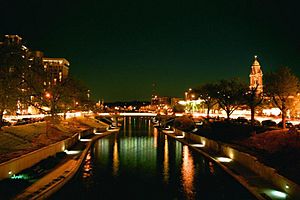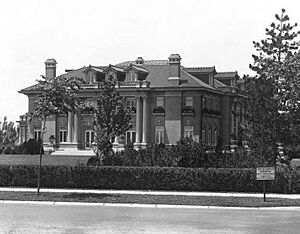Ward Parkway facts for kids

Ward Parkway, split by Brush Creek in the Country Club Plaza near its eastern terminus
|
|
| Namesake | Hugh Campbell Ward, son of Seth E. Ward |
|---|---|
| Type | boulevard |
| Length | 6.8 mi (10.9 km) |
| Coordinates | 39°0′0.2″N 94°36′11.9″W / 39.000056°N 94.603306°W |
| North | Brookside Boulevard / Volker Boulevard |
| South | Wornall Road |
| Other | |
| Known for | High-class neighboorhoods, redlining, fountains |
| Ward Parkway | |
|---|---|
| Type | Boulevard median greenspace |
| Location | Kansas City, Missouri, United States |
| Area | 211.14 acres (0.8545 km2; 0.32991 sq mi) |
| Designer | J.C. Nichols |
| Owned by | City of Kansas City, Missouri |
Ward Parkway is a beautiful, long street in Kansas City, Missouri, United States. It's known as a boulevard, which means it's a wide street with trees and green spaces. Ward Parkway starts at Brookside Boulevard near the Country Club Plaza. It goes west for about 2.8 miles along Brush Creek. Then, it turns south and continues for 4 miles, ending at Wornall Road.
The street is named after the family of a local businessman named Seth E. Ward (1820-1903). His family owned a lot of land in the area. Their old mansion, located at 1032 West 55th Street, is still standing on Ward Parkway. It's even listed on the National Register of Historic Places, which means it's an important historical building.
Ward Parkway has a wide, green area in the middle, called a median. This median is decorated with many pretty fountains and statues. Many of Kansas City's largest and most beautiful houses are built along Ward Parkway. These homes are part of the carefully planned Country Club District.
Contents
Exploring Ward Parkway's Location
Ward Parkway stretches across Kansas City, Missouri. It connects different parts of the city.
- Northern end: The parkway begins where Brookside Boulevard and Volker Boulevard meet. 39°02′22″N 94°35′07″W / 39.03932°N 94.58529°W
- Southern end: It finishes at Wornall Road. 38°57′33″N 94°35′44″W / 38.95918°N 94.59568°W
The Story Behind Ward Parkway
Ward Parkway was created as part of a big plan by a developer named J.C. Nichols. He wanted to build a boulevard that was more beautiful than any other street in Kansas City.
Designing a Dream Street
Nichols hired a talented landscape architect named George Kessler. Kessler had designed many other boulevards, parks, and neighborhoods in Kansas City. The street was named after Hugh Campbell Ward (1864-1909), a lawyer and business partner of J.C. Nichols. Hugh Ward's family donated their land to the city for the parkway.
Starting in 1906, Nichols set aside space for Ward Parkway as he planned the Country Club District. He made sure the largest plots of land were saved for the grand houses that would be built along the boulevard. The Kansas City Parks Department officially made Ward Parkway part of its boulevard system.
Adding Art and Beauty
J.C. Nichols traveled to Italy and England to buy statues and monuments. He placed these beautiful artworks in the wide median of the boulevard. He also added ponds and decorative urns along the parkway. To show off his new development, Nichols often put pictures of the large houses on Ward Parkway in the Sunday newspaper, The Kansas City Star. He even moved into one of the houses himself!
Highways and History
For many years, a section of Ward Parkway was part of U.S. Route 50. Later, in 1957, U.S. Route 56 also began to use this part of Ward Parkway. Today, a half-mile section of Ward Parkway is still maintained as U.S. Route 56.
Many important families in Kansas City chose to build their homes on Ward Parkway. Some famous examples include the homes of Tom Pendergast, Bernard Corrigan, and Mack B. Nelson. Living near Ward Parkway became a sign of importance in Kansas City society. Even today, many of the city's wealthiest and most educated people live near Ward Parkway.
In 2012, Ward Parkway was recognized as a "Great Street" by the American Planning Association. They praised how much people and the city government cared for the parkway. This care has helped it remain a highly desired place to live, with historic homes, parks, pretty fountains, and lovely landscapes.
Keeping Ward Parkway Beautiful
People in Kansas City work hard to keep Ward Parkway looking great.
Funding for Improvements
In 2011, a special area called the Ward Parkway Center Community Improvement District was created. This allows the city to collect a small sales tax to help pay for projects along the parkway. One project that got help was the Ward Parkway Center, a large shopping mall near the southern end of the parkway. The city has also spent over $9 million to maintain and improve the park grounds, fountains, and recreational areas along the parkway.
Protecting History
Many buildings and sites along Ward Parkway are important historical places. They are listed on the National Register of Historic Places. These include the Park Manor Historic District, the Serena Apartment Hotel, and the Alexander Majors Antebellum house. To make sure the parkway's historic look is kept, new buildings must follow special design rules. They also need approval from the Historic Preservation Committee.
Places to See on Ward Parkway
Ward Parkway is home to many interesting places:
- Kansas City Public Library Plaza Branch: A library located near the start of Ward Parkway.
- Country Club Plaza: A popular outdoor shopping center.
- InterContinental Kansas City at the Plaza: A large hotel.
- The Pembroke Hill School Ward Parkway Campus: A school campus.
- The Carriage Club: A private club.
- Mirror Pool Fountain: A beautiful fountain in the middle of the parkway.
- The Meyer Circle Sea Horse Fountain: This fountain has a 17th-century sculpture from Venice.
- Alexander Majors Historic Museum and Barn: A historic building and museum.
- Ward Parkway Center: A large indoor shopping mall.
- Burns & McDonnell: The main office for an architecture and engineering company.
Notable People Who Lived on Ward Parkway
Many well-known people have lived in homes along Ward Parkway, including:
- Tom Pendergast: A powerful political leader in Kansas City's past.
- Keith A. Tucker: Former CEO of Waddell & Reed, a mutual fund company.
- Peter Brown: CEO and co-founder of AMC Theatres.
- Jason Kander: A politician.
- Richard Bloch: Co-founder of H&R Block, a tax preparation company.



